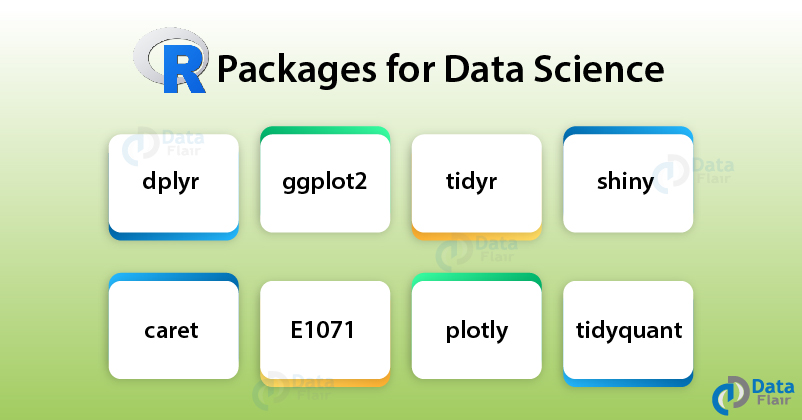8 Useful R Packages for Data Science – Get a thorough understanding!
FREE Online Courses: Click for Success, Learn for Free - Start Now!
In our R Tutorial DataFlair series, now we will take a brief look at the eight useful R packages for Data Science.
But before that, we would strongly recommend you to go through our previous article on R for Data Science. Because without knowing the basic relation between both of them, you can’t move ahead and understand the use of R packages for Data Science.
R is the most widely used programming language for statistics and it has formed its foothold in Data Science. So, let’s start the tutorial.
R Packages for Data Science
R has over 10,000 packages in the CRAN repository. Being the most popular language of choice for statistical modeling, R provides a diverse range of libraries. While it is not possible to list out all the libraries, we will discuss the most common and useful libraries that Data Scientists use in their everyday tasks.
Below is the explanation of essential R Packages for Data Science:
1. dplyr
For performing data wrangling and data analysis, we make use of the dplyr package. We use this package for facilitating various functions for Data frame in R. Furthermore, data scientists use this package for carrying out several functions with the data frames.
2. ggplot2
This is the most popular visualization package that is created for R. ggplot2 is popular as it facilitates declarative creation of graphics. With this package, you can create aesthetically pleasing and elegant plots and graphs.
3. tidyr
tidyr is a package that we use for tidying the data. We consider this data to be tidy when each variable represents a column and each row represents an observation.
4. shiny
shiny is an interactive web application that allows you to embed visualizations like graphs, plots, and charts. These interfaces are directly written in R and provide a customizable slider widget that has built-in support for animation.
5. caret
The caret package is short for Classification and Regression Training. Using this function, you can model complex regression and classification problems. One important extension of the caret is CaretEnsemble which is used for combining different models.
6. E1071
This package has wide use for implementing clustering, Fourier Transform, Naive Bayes, SVM and other types of miscellaneous functions.
Learn everything about e1071 Package and SVM Training in R
7. plotly
This package extends on the JavaScript library which is mainly for building interactive quality graphs. We can then embed these graphs on web applications quite easily.
8. tidyquant
tidyquant is a package that we use for carrying out financial operations on the data. Data Scientists use this package for carrying out quantitative financial analysis.
Summary
Here we conclude our tutorial on R Packages for Data Science. In the above article, we talked about the libraries that we can use for data analysis, visualization and other important data operations. R is constantly evolving and its number of packages are growing. If you have any other package that you consider to be useful for Data Science, make sure to leave that in the comment.
Next, you must go through our tutorial on Machine Learning for R
Hope the information provided was useful to you. Don’t forget to drop your feedback below in the comment section.
We work very hard to provide you quality material
Could you take 15 seconds and share your happy experience on Google


